#Digital Engine Tachometer
Explore tagged Tumblr posts
Text
Enhancing Your Vehicle’s Performance with a Digital Engine Tachometer

When it comes to optimizing engine performance, the right tools are crucial. One standout instrument in this category is the Ono Sokki Digital Engine Tachometer. This advanced device not only delivers accurate measurements of engine RPM (Revolutions Per Minute) but also enhances diagnostic capabilities across various applications. Let’s delve into how the tachometer can elevate your engine management experience.
A precision rotational speed measurement device is used to measure the speed of engines and motors. Its clear digital display of RPM makes it ideal for use in industrial and laboratory settings. Its compact and portable design allows for easy use in the field, ensuring performance monitoring wherever needed.
Benefits of the Digital Engine Tachometer
1. Accurate Performance Monitoring
One of the key advantages is its ability to provide real-time RPM data. This instant feedback allows engineers and technicians to make informed adjustments to optimize performance, whether in a workshop or out in the field.
2. Versatile Applications
This tachometer is versatile, accommodating both gasoline and diesel engines, as well as electric and hybrid vehicles (EV/HEV). In addition to measuring rotational speed, it is able to measure the rotational speed of a wide variety of motors and rotating bodies.
3. Enhanced Diagnostics
Equipped with advanced diagnostic features, the Hand Held Tachometer helps monitor engine health effectively. It can detect potential issues early, such as misfires or irregular RPM readings, allowing for timely interventions that can save time and money on repairs.
4. Compatibility with Multiple Sensors
The CT-6700 model supports ten different types of sensors, including ignition pulse detectors and magneto-electric rotation detectors. This flexibility makes it adaptable to various engine types and applications, ensuring accurate readings regardless of the setup.
5. Innovative Measurement Techniques
The ability to measure engine rotation speed using ECU crank signals is a notable feature, especially when mounting a detector is impractical. This innovation streamlines the monitoring process, providing reliable data without the need for complex installations.
Installation and Considerations
Installing the Tachometer is generally straightforward, particularly for those familiar with engine systems. Most units come with detailed installation instructions. However, if you’re not comfortable with installation, consulting a professional is recommended to ensure optimal performance.
Key Considerations:
Compatibility: Make sure that your tachometer is compatible with your vehicle's engine type and application.
Features: Discover the extensive range of features, such as sensor compatibility and diagnostics.
Brand Reputation: Opt for a trusted brand like Ono Sokki, known for delivering quality and reliability.
Conclusion
The Digital Engine Tachometer is more than just a measuring instrument; it’s an essential asset for anyone looking to enhance engine performance and diagnostics. With its accurate monitoring, versatility, and advanced features, investing in this tachometer can lead to improved efficiency and reliability in engine management. Whether you’re a seasoned technician or a dedicated enthusiast, this technology provides the insights necessary to take your engine performance to new heights.
For any clarifications or queries, please feel free to contact us:
Mobile: +91��92055–92194 or +91–92055–92195
Email ID: [email protected]
Website: www.onosokki.co.in
0 notes
Text

1968 AMC AMX
408-Powered 1968 AMC AMX 4-Speed
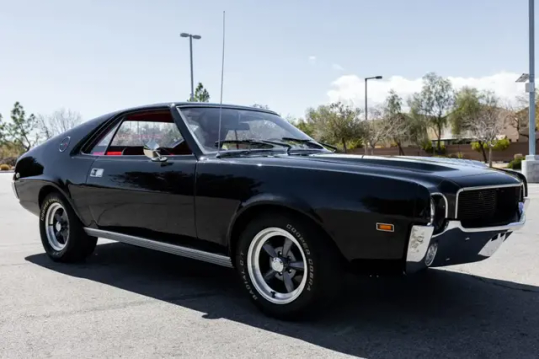
1968 AMC AMX
This 1968 AMC AMX was modified under previous ownership during a refurbishment that is said to have been conducted over the course of 10 years and was completed in 2013. Refinished in black over red vinyl upholstery, the car is powered by a 408ci V8 paired with a four-speed manual transmission. Refurbishment work reportedly involved resurfacing the cylinder heads as well as installing an Edelbrock intake manifold, a performance camshaft, Hooker long-tube exhaust headers, billet pulleys, an aluminum radiator, cross-drilled front brake rotors, and lowering springs. Additional equipment includes 15″ Vision wheels, aftermarket headlights, chrome bumpers, a Hurst shifter, tilt steering, and a push-button AM radio. The seller acquired the vehicle in 2015. This modified AMX is now offered with a service manual, books, a model kit, unused Go Package–style stripe decals, spare and removed parts, and a Nevada title in the seller’s name.

1968 AMC AMX
The car was refinished in black as part of the aforementioned refurbishment. Additional work is said to have included repainting the wheel wells and the floors along with replacing the bumpers, door handles, grille, mirrors, headlights, weatherstripping, and bright trim on the window and headlight surrounds. The “AMX” badging on the exterior features red letter Xs.

1968 AMC AMX
Aftermarket 15″ Vision wheels are mounted with 215/60 front and 265/50 rear Cooper Cobra Radial G/T tires. A space-saver spare is located in the trunk. The car is equipped with lowering springs, and braking is provided by cross-drilled front discs and rear drums.

1968 AMC AMX
The split front bench seat is trimmed in red vinyl upholstery complemented by a color-coordinated dashboard, door panels, and carpeting. Other features include crank windows, a fold-down armrest, a Hurst shifter, tilt steering, and an American Motors–branded push-button AM radio. The headliner, carpets, and sill plates were replaced under previous ownership.

1968 AMC AMX
The three-spoke steering wheel fronts a 120-mph speedometer, a tachometer, and a combination gauge for fuel level and coolant temperature. An AutoMeter tachometer is mounted to the steering column, and a trio of smaller AutoMeter gauges affixed beneath the dashboard monitors oil temperature, coolant temperature, and oil pressure. The five-digit odometer shows 13k miles, less than 500 of which have been added by the seller; true mileage is unknown. The seller notes that the clock and the factory tachometer do not work.

1968 AMC AMX
The engine is said to be an AMC 390ci V8 that was bored and stroked to displace 408ci. Additional work during the refurbishment included resurfacing the cylinder heads as well as installing forged engine internals, an Edelbrock intake manifold, a performance camshaft, ceramic-coated Hooker long-tube exhaust headers, billet pulleys, an aluminum radiator with electric fans, and an aftermarket exhaust system. An oil change and coolant flush were performed in preparation for the sale. The car’s chassis number indicates that it was originally equipped with a 360ci V8 topped by a two-barrel carburetor.

1968 AMC AMX
Power is sent to the rear wheels through a four-speed manual transmission and a Twin-Grip rear axle with 3.55:1 gearing. An Ace Racing Powerforce clutch was fitted during the refurbishment.

1968 AMC AMX
A 1968 AMC service manual, books and magazines, an AMT model kit, unused Go Package–style red stripe decals, and spare and removed parts will accompany the vehicle.
The Nevada title notes the odometer brand “Exempt.”
370 notes
·
View notes
Text

You can now have your ``big dream in a small car'' in your hands.
MIRA Turbo TR-XX
New release on October 21st.
MIRA Turbo TR-XX SPECIFICATIONS ENGINE: EB-type model, Water-cooled 4-cycle OHC 3-cylinder in line, Transverse (Turbo charged with Intercooler)
MAXIMUM OUTPUT: 52PS/6500rpm
MAXIMUM TORQUE: 7.1kg-m/4000rpm POWER PER LITER: 95PS
FUEL-EFFICIENCY(at the speed of 60km/h): 31km/L
BRAKES: (Front) Boosted Disk Brakes (Rear) Boosted Leading Trailing Brakes SUSPENSION: (Front) MacPherson Strut, Coil Spring (with Stabilizer)
(Rear) Semi-Trailing, Coil Spring TIRES: 145/70 SR 12 Steel Radial
Can the form exceed the specifications?
It has a form that cuts through the wind. Aero tuned mini that achieved a CD value of 0.35. What accelerates this aero body is a powerful muscle with a maximum output of 52PS/6,500rpm and a maximum torque of 7.1kgm/4,000rpm. The newly developed 3-cylinder intercooled turbo engine produces overwhelmingly high power. The TR Double X is now running with the super spec on the super form.
Who will ride it?
A 3-spoke 365 small-diameter urethane steering wheel exclusively for the TR Double X with a fearless racer-like design. A gun grip type shift lever that can be operated quickly and comfortably. Large 2-meter tachometer and speedometer that can be read instantly.
Graphic type turbo indicator. Everything is for sporty running.
It's a cockpit that caters to the finely honed motor skills.
Car component & console box, digital clock optional
Seat set firmly. Boldly protruding side support. In tight corners, the movement of the upper body is reduced, ensuring reliable handling. Finally, there is a bucket-type front seat exclusively for the TR Double X that reduces fatigue on long drives. The Spartan driving performance has made the seat so authentic. Car combo & speaker & console box are optional
23 notes
·
View notes
Text
Measuring Instruments 101: Understanding the Different Types and Their Uses
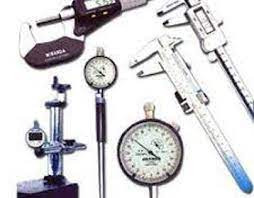
Do you find yourself confused when it comes to measuring instruments? With so many different types and uses, it can be overwhelming to understand which instrument is best suited for your needs. In this blog post, we will break down the basics of measuring instruments and provide you with a comprehensive guide to understanding the different types and their uses. Whether you are a DIY enthusiast or a professional in need of accurate measurements, this post will help you navigate the world of measuring instruments with ease.
1. Familiarize Yourself with the Basic Types of Measuring Instruments
To begin your journey into understanding measuring instruments, it is important to familiarize yourself with the basic types. This includes rulers, tape measures, calipers, micrometers, and levels. Each type has its own specific purpose and application, so understanding their differences is crucial.
2. Learn How to Use a Ruler or Tape Measure
One of the most common and versatile measuring instruments is the ruler or tape measure. Learning how to use these tools correctly will provide you with accurate measurements for various projects. We will explain the different units of measurement, how to read measurements, and tips for measuring accurately.
3. Dive into the World of Calipers
Calipers are precision measuring instruments used for more detailed measurements. There are two main types of calipers: vernier calipers and digital calipers. We will explore the differences between the two and guide you on how to use them effectively.
4. Understand the Function of Micrometers
Micrometers are highly accurate measuring instruments used for measuring small objects or components. They are commonly used in fields such as engineering, manufacturing, and machining. We will explain how to read a micrometer and provide tips for precise measurements.
5. Get to Know Levels and Their Uses
Levels are essential tools for ensuring that surfaces and objects are perfectly horizontal or vertical. We will discuss the different types of levels, including bubble levels and laser levels, and explain how to use them correctly.
6. Consider Specialized Measuring Instruments for Specific Applications
In addition to the basic types of measuring instruments, there are specialized instruments for specific applications. These can include inclinometers, tachometers, and sound level meters. We will provide an overview of these instruments and their uses.
7. Practice Using Measuring Instruments
The best way to become proficient in using measuring instruments is through practice. We will provide tips on how to practice using different instruments and suggest projects or exercises to improve your skills.
8. Invest in Quality Measuring Instruments
Lastly, investing in quality measuring instruments is crucial for accurate and reliable measurements. We will discuss the importance of choosing reputable brands and provide recommendations for reliable instruments.
Conclusion
By following these steps and gaining a solid understanding of the different types and uses of measuring instruments, you will be well-equipped to tackle any measuring task that comes your way. Whether you are a DIY enthusiast or a professional, accurate measurements are essential for successful projects. So, dive into the world of measuring instruments with confidence and start measuring like a pro!
2 notes
·
View notes
Text
Analog vs. Digital Dash Clusters: Which Is Better for Modern Vehicles?

When you sit inside a car, one of the first things you notice is the dashboard—the cluster of instruments that gives you key information like your speed, fuel level, engine temperature, and more. It’s the central hub that keeps drivers informed and in control while on the road. For decades, these clusters were entirely analog, featuring physical dials and needles that moved mechanically. They were simple, effective, and familiar to most drivers.
But now, with the rise of advanced technology, smarter vehicles, and higher expectations from drivers, digital dash clusters are quickly taking over. These modern systems use high-resolution screens to display the same essential information, but with greater flexibility, customization, and integration with other vehicle systems.
So, which one is better for modern vehicles—analog or digital? In this blog, we’ll explore the differences between analog and digital dash clusters, the pros and cons of each, and how they affect the overall driving experience. Whether you’re buying a new car, upgrading an old one, or just curious about automotive tech trends, this guide will help you understand what’s best for today’s vehicles and why dashboards are evolving fast.
What is a Dash Cluster?
A dash cluster, or instrument cluster, is the panel in front of the driver that displays key vehicle information. This includes:
Speedometer (vehicle speed)
Tachometer (engine RPM)
Fuel gauge
Temperature gauge
Warning lights (e.g., engine, oil, seatbelt)
There are two main types:
Analog Dash Clusters: Use physical dials and needles to show readings.
Digital Dash Clusters: Use electronic displays—like LCD or TFT screens—to show data in a visual, dynamic format.
Understanding Analog Dash Clusters
Analog dashboards have been standard for most of automotive history. These dashboards display readings using mechanical or electromechanical systems. You’ll see spinning needles, rotating dials, and often a simple digital odometer.
Pros of Analog Dash Clusters
Simplicity and Clarity:Analog gauges are easy to understand at a glance. Most drivers are familiar with them and don’t need time to adjust.
Lower Cost:Cars with analog clusters are generally more affordable. There are fewer electronic components to worry about.
Fewer Distractions:Analog displays are static and consistent, helping drivers focus without too many visual elements changing on-screen.
Durability:Mechanical gauges tend to be more resilient over time. They don’t suffer from dead pixels or software glitches.
Cons of Analog Dash Clusters
Limited Information:Analog clusters show only basic data. They can’t display navigation, media info, or custom alerts.
Lack of Customization:You can’t change how your gauges look or rearrange them. What you see is what you get.
No Integration with Advanced Systems:Modern cars come with advanced features like lane assist, real-time maps, and performance metrics, which analog systems can't support.
Understanding Digital Dash Clusters
A digital instrument cluster replaces traditional dials with a screen—often high-resolution and fully customizable. These clusters are becoming standard in luxury cars and are appearing in mid-range models as well.
Pros of Digital Dash Clusters
Customizable Layouts:Drivers can switch between different display modes—performance mode, eco mode, or navigation view. Some even support Custom Digital Dash settings, allowing you to personalize the screen.
More Data at a Glance:Digital clusters can show additional information like turn-by-turn navigation, media playback, weather updates, tire pressure, and more.
Enhanced Visual Appeal:These clusters often look sleek, modern, and futuristic—great for tech-savvy drivers or those who appreciate good design.
Integration with Vehicle Systems:They work seamlessly with infotainment systems, ADAS (Advanced Driver-Assistance Systems), and other smart features in the car.
Improved Night Driving:Brightness and contrast automatically adjust for better visibility without causing eye strain at night.
Cons of Digital Dash Clusters
Higher Cost:Vehicles with digital displays tend to be more expensive due to the advanced hardware and software involved.
Complexity:The abundance of information and custom settings can be overwhelming, especially for older or less tech-friendly drivers.
Potential for Glitches:As with any screen, software bugs or hardware malfunctions can occur. A faulty digital display could leave the driver with no readable info.
Distraction Risk:With animations, alerts, and switching modes, there’s a risk of drivers focusing too much on the screen instead of the road.
Analog vs. Digital: Side-by-Side Comparison

Which One Is Better for Modern Vehicles?
This depends on how you define “better.” For modern vehicles that aim to provide an advanced driving experience, digital instrument clusters offer greater flexibility, interactivity, and data. They are perfect for tech-driven cars with connected features and intelligent systems.
However, analog clusters still have a place in the market. They are easier to maintain, less prone to tech issues, and provide a nostalgic or minimalist driving feel. Budget vehicles and some classic-style models still favor analog clusters for their simplicity and reliability.
Ultimately, the “better” option depends on your preferences and driving needs:
Daily commuter? Analog might suit you just fine.
Tech lover or long-distance driver? You’ll likely benefit from a digital system.
Car enthusiast? You might prefer a custom digital dash for performance stats, track data, and visual flair.
The Rise of Hybrid Clusters
To bridge the gap, many manufacturers now offer hybrid instrument clusters, combining analog-style dials with a small digital screen in the center. This gives drivers the best of both worlds:
Familiar dials for basic info
A digital section for navigation, calls, or system alerts
Examples include models from Toyota, Hyundai, and Ford, which give buyers flexibility without fully committing to digital.
Use Cases: When Digital Really Shines
1. Navigation Support
Digital clusters often sync with GPS and show maps directly behind the steering wheel, reducing the need to look sideways at the infotainment screen.
2. Electric Vehicles (EVs)
EVs often need to display new types of information—like battery range, charging status, and energy usage. A digital display makes this easier to interpret.
3. Performance Driving
For sports cars or track use, drivers benefit from a custom digital dash that shows lap times, G-forces, and engine performance metrics.
4. Luxury Cars
Premium brands like Mercedes-Benz, BMW, and Audi are making fully digital clusters standard across their lineup to reflect modernity and status.
Future Trends in Dash Clusters
Augmented Reality (AR):Some vehicles now project data onto the windshield using AR, showing speed, navigation, and warnings in the driver’s line of sight.
Voice Integration:Dash clusters will soon be fully voice-enabled, letting you switch views or get information hands-free.
Cloud-Connected Dashboards:Expect real-time traffic, weather, and system diagnostics streamed directly to your display.
Full Personalization Profiles:Your driving profile might auto-load your preferred layout, lighting, and theme the moment you start the car.
Making the Right Choice
If you’re shopping for a car or upgrading your dash, ask yourself:
Do I want modern features or classic simplicity?
Am I comfortable with tech-heavy systems?
Do I need real-time maps, media info, or system alerts?
What’s my budget?
If customization, connectivity, and visual appeal matter most, a digital instrument cluster is the way to go. If simplicity and durability are your top priorities, analog still has its place.
Final Thoughts
The dashboard has come a long way—from a basic panel of gauges to a sophisticated, interactive display that plays a vital role in how we drive. It’s no longer just about speed and fuel—it’s about real-time data, seamless connectivity, and personalized driving experiences. Whether you’re drawn to the classic charm and simplicity of analog dials or excited by the sleek design and functionality of a digital display, there’s an option to suit every driver.
As the automotive industry continues to innovate, digital dash clusters—especially those offering custom digital dash features—are quickly becoming the new norm. With the ability to display a wide range of vehicle data, adapt to driving modes, and even integrate with smartphones and navigation, digital systems offer unmatched flexibility and convenience. However, analog dashboards still appeal to many drivers who appreciate their straightforward layout and traditional feel.
Ultimately, the right dashboard for you depends on your personal preferences, the type of vehicle you drive, and how comfortable you are with modern technology. Whether you're upgrading your current car or purchasing a new one, understanding your dashboard options can help you make a better, more informed choice.
In the end, the best dashboard is the one that enhances your driving experience—offering you confidence, clarity, and control every time you get behind the wheel.
0 notes
Text
Honda CBR300R: The Lightweight Sports Bike Returns

The Honda CBR300R is making a return to the Indian market, and it’s already generating buzz among motorcycle enthusiasts. With its compact build, sharp styling, and practical performance features, the CBR300R stands out as a promising option for those who want a balanced sports bike — whether you’re a beginner or a daily rider.
Let’s explore what makes the new CBR300R worth waiting for.
Engine & Performance
The new CBR300R is powered by a 286cc single-cylinder, liquid-cooled engine. This engine delivers around 30 horsepower and 27 Nm of torque, making it capable enough for both city commuting and occasional highway rides. The six-speed gearbox ensures smooth transitions, allowing riders to extract optimal performance across different terrains.
Despite being a single-cylinder bike, the CBR300R maintains a refined feel, which is a hallmark of Honda’s engineering. The fuel injection system contributes to better throttle response and fuel efficiency, offering practicality for daily use.
Design and Build
The bike maintains the signature CBR family styling with an aggressive front fairing, sharp lines, and dual headlamps. The aerodynamic bodywork is designed not only to look good but also to reduce wind resistance, contributing to better stability at higher speeds.
It offers a comfortable seating position with slightly rear-set footpegs and clip-on handlebars, providing a sporty yet manageable riding posture. The sculpted tank allows for better leg grip, enhancing rider control.
Ride and Handling
Built on a steel frame, the CBR300R features a 37mm front telescopic fork and Pro-Link rear mono-shock. These components strike a good balance between stiffness and comfort, making the bike suitable for both daily commuting and weekend leisure rides.
Its lightweight chassis and compact geometry give it nimbleness in traffic while maintaining stability at higher speeds. With a kerb weight of around 164 kg, it’s easy to maneuver in urban settings.
Braking and Safety
The bike comes equipped with disc brakes at both ends — 296mm at the front and 220mm at the rear. Dual-channel ABS will likely be standard, which is essential for riders who value safety in unpredictable road conditions.
The braking system is responsive, offering enough stopping power without compromising control, especially useful in wet or uneven surfaces.
Features and Technology
While the CBR300R keeps things simple, it doesn’t compromise on the essentials:
Digital-analog instrument cluster with speedometer, tachometer, fuel gauge, and trip meter
LED headlight and tail lamp for better visibility
Comfortable split seat for rider and pillion
Under-seat storage space for basic tools and documents
Honda seems focused on delivering a rider-centric experience without overcomplicating the user interface with unnecessary tech.
Fuel Efficiency and Practicality
The bike is expected to deliver a mileage of around 30–35 km/l, depending on riding habits. Combined with a fuel tank capacity of approximately 13 liters, this makes it quite practical for longer rides with fewer fuel stops.
The upright yet sporty stance also ensures that city commutes and weekend getaways are equally enjoyable.
Who Should Buy the Honda CBR300R?
If you’re a beginner looking to upgrade from a 150cc or 200cc motorcycle or a seasoned rider looking for a lightweight, no-fuss sports bike for daily use, the CBR300R ticks most of the boxes.
It’s approachable, reliable, and refined — ideal for anyone who wants a balance between performance and day-to-day usability.
Maintenance and Spare Parts Availability
As with any performance bike, access to genuine spare parts is essential. That’s where platforms like GNG GO come in. Whether you’re upgrading components or replacing worn-out parts, you can easily find a wide range of online spare parts for sports bike to keep your CBR300R in top shape. The convenience of ordering high-quality parts online ensures that your maintenance schedule never takes a hit.
Final Thoughts
The Honda CBR300R is shaping up to be a well-rounded machine that brings Honda’s proven engineering to a category that values reliability and versatility. With its powerful engine, responsive handling, and daily usability, it’s a sports bike that fits effortlessly into your routine.
As the launch approaches, riders looking for an affordable yet premium entry into the world of sports biking should keep their eyes on the CBR300R — and their tools ready at GNG GO, your trusted source for all things motorcycle.
0 notes
Text
Car Instrument Cluster Repair Specialists: High-quality service and client satisfaction!
The instrument cluster or dashboard is the vital nerve center of your vehicle, providing crucial real-time information about its performance and safety. A malfunctioning cluster, with its flickering lights, erratic gauges, or unreadable displays, can be frustrating. It also compromises your driving safety and experience. Fortunately, replacing the entire unit is often unnecessary. Specialised cluster repair services like Cartronix offer comprehensive car instrument cluster repair services, restoring your dashboard to its optimal functionality.

Who is a Car Instrument Cluster Repair Specialist?
The Car Instrument Cluster Repair Specialists possess the key knowledge and technical skills to diagnose and resolve wide-ranging issues within your vehicle's instrument panel. This includes tackling problems such as dim or inconsistent backlighting, the frustrating appearance of dead pixels on digital displays, erratic or non-functional speedometer and tachometer readings, and inaccuracies in fuel and temperature gauges. These specialists are knowledgeable in identifying and rectifying the underlying electrical and electronic faults within the cluster.
Common Instrument Cluster Issues
Pixel Loss and Unreadable Displays – Restore clarity to digital screens affected by missing or dead pixels.
Flickering or Failed Backlighting – Ensure consistent and clear illumination of your instrument panel.
Dead Speedometers or Tachometers - Bring crucial speed and engine RPM readings back to life.
Faulty Fuel or Temperature Gauges - Provide accurate information on your vehicle's vital fluid levels.
Total Power Failure of Dashboard- Diagnosis and resolving complete loss of function in the instrument cluster.
Why Choose Cartronix
Specialists in Digital Dashboard and LCD Pixel Repair
With a strong reputation built on top-quality services and a relentless commitment to client satisfaction, Cartronix has established itself as a leading specialist in digital dashboard and LCD pixel repair. They offer repair services to a wide range of instrument cluster malfunctions, such as failing gauges, flashing warning lights or backlights, and complete power failure. Vehicle owners grappling with unreadable LCD displays on their speedometer or radio, or those plagued by missing pixels, can greatly benefit from its specialised repair services.
Wide-array of features of their services
Cartronix offers a top-class cluster repair service in the UK, equipped with a trained team of Car Instrument Cluster Repair Specialists prioritizing your complete satisfaction. The features of service include -
Lifetime Warranty - Demonstrating their unwavering commitment to the quality and durability of their repairs.
Original Data Retained - Ensuring no loss of crucial vehicle information like mileage or configuration.
Cost-Effective Repairs - Offering significant savings compared to the expense of replacing the entire instrument cluster.
Fast Turnaround - Providing quick diagnostics and efficient repair services to minimize disruption.
Full Range of Services - Extending beyond cluster repairs to include LCD pixel repairs, key and key card repairs, audio system decoding, performance tuning and ECU remapping, and airbag module crash data removal.
#Instrument Cluster Repair Specialists#Car Instrument Cluster Repair Specialists#lcd Pixel Repair uk#lcd pixel repair for cars#cluster repair service#Display Fixing Specialists#car cluster repair#instrument cluster removal and refitting service#digital dashboard repair#digital dashboard and LCD pixel repair
1 note
·
View note
Text
Car Instrument Cluster Repair Specialists: High-quality service and client satisfaction!
The instrument cluster or dashboard is the vital nerve center of your vehicle, providing crucial real-time information about its performance and safety. A malfunctioning cluster, with its flickering lights, erratic gauges, or unreadable displays, can be frustrating. It also compromises your driving safety and experience. Fortunately, replacing the entire unit is often unnecessary. Specialised cluster repair services like Cartronix offer comprehensive car instrument cluster repair services, restoring your dashboard to its optimal functionality.

Who is a Car Instrument Cluster Repair Specialist?
The Car Instrument Cluster Repair Specialists possess the key knowledge and technical skills to diagnose and resolve wide-ranging issues within your vehicle's instrument panel. This includes tackling problems such as dim or inconsistent backlighting, the frustrating appearance of dead pixels on digital displays, erratic or non-functional speedometer and tachometer readings, and inaccuracies in fuel and temperature gauges. These specialists are knowledgeable in identifying and rectifying the underlying electrical and electronic faults within the cluster.
Common Instrument Cluster Issues
Pixel Loss and Unreadable Displays – Restore clarity to digital screens affected by missing or dead pixels.
Flickering or Failed Backlighting – Ensure consistent and clear illumination of your instrument panel.
Dead Speedometers or Tachometers - Bring crucial speed and engine RPM readings back to life.
Faulty Fuel or Temperature Gauges - Provide accurate information on your vehicle's vital fluid levels.
Total Power Failure of Dashboard- Diagnosis and resolving complete loss of function in the instrument cluster.
Why Choose Cartronix
Specialists in Digital Dashboard and LCD Pixel Repair
With a strong reputation built on top-quality services and a relentless commitment to client satisfaction, Cartronix has established itself as a leading specialist in digital dashboard and LCD pixel repair. They offer repair services to a wide range of instrument cluster malfunctions, such as failing gauges, flashing warning lights or backlights, and complete power failure. Vehicle owners grappling with unreadable LCD displays on their speedometer or radio, or those plagued by missing pixels, can greatly benefit from its specialised repair services.
Wide-array of features of their services
Cartronix offers a top-class cluster repair service in the UK, equipped with a trained team of Car Instrument Cluster Repair Specialists prioritizing your complete satisfaction. The features of service include -
Lifetime Warranty - Demonstrating their unwavering commitment to the quality and durability of their repairs.
Original Data Retained - Ensuring no loss of crucial vehicle information like mileage or configuration.
Cost-Effective Repairs - Offering significant savings compared to the expense of replacing the entire instrument cluster.
Fast Turnaround - Providing quick diagnostics and efficient repair services to minimize disruption.
Full Range of Services - Extending beyond cluster repairs to include LCD pixel repairs, key and key card repairs, audio system decoding, performance tuning and ECU remapping, and airbag module crash data removal.
#Instrument Cluster Repair Specialists#Car Instrument Cluster Repair Specialists#lcd Pixel Repair uk#lcd pixel repair for cars#cluster repair service#Display Fixing Specialists#car cluster repair#instrument cluster removal and refitting service#digital dashboard repair#digital dashboard and LCD pixel repair
0 notes
Text
Why You Should Buy The 2025 Toyota GR Supra
The 2025 Toyota GR Supra is here and ready to leave its (tire) mark. Now made in two grades (the 3.0 and the 3.0 Premium), this sports car is built with top performance, speed, and design that you’ll fall in love with. Before you come in for a test drive, here are Toyota of Orlando’s favorite features of the 2025 Toyota GR Supra!

The GR Supra is Built for Speed
With the 2025 Toyota GR Supra, you can choose between two different transmissions: a six-speed intelligent manual transmission or an eight-speed automatic transmission with paddle shifters. Other features include:
Rear-Wheel Drive (RWD)
A 3.0L twin-scroll single turbo inline 6-cylinder engine
Chassis braces in the engine bay to enhance steering and handling
Active Rear Sport Differential
Adaptive Variable Sport (AVS) Suspension
Brembo fixed-caliper disc brakes
And if you need even more convincing, the 2025 Toyota GR Supra can go from 0 to 60 in just 3.9 seconds! That’s with 382 horsepower at 5800-6500 rpm, giving you 368 lb-ft of torque.

A Sleek, Sport Design
The Supra has always had a unique design that distinguished itself from other popular sports cars in the market, so it’s no surprise that the 2025 Toyota GR Supra has taken it a step further. This Toyota is built to support you at every speed and includes:
19-inch frozen gunmetal gray forged-aluminium wheels with Michelin Pilot Super Sport tires
Dual rear exhaust outlets with brushed stainless steel exhaust tips
Aerodynamic underbody panel
LED headlights with two-level, 6-lens LED light clusters
Matte-black auto-folding, heated outside mirrors
Exterior color options like Stratosphere, Absolute Zero, Nocturnal, and Renaissance Red 2.0
These features make it even easier to upgrade your Toyota Supra to your heart’s content!
Cruise with Comfort
You won’t have to worry about giving up comfort for performance with this Orlando Toyota. The interior has plenty of luxurious touches and details that we love, such as:
Heated seats with deep, power-adjustable side bolsters
Knee-support cushions
Lined, locking glove box
Luggage compartment with bag hooks
Storage net on the passenger side
Carbon fiber interior trim
Black leather-wrapped 3-spoke steering wheel with paddle shifters
Leather-trimmed shift knob
Sport pedals

Top Tech for Every Turn
We’re making your drive even easier with new and improved technology! Four main aspects of these updated tech features make the 2025 Toyota GR Supra a sophisticated choice for all Orlando drivers.
Supra Connect - In the car, you’re equipped with automatic emergency calls, real-time traffic information, and roadside assistance. With the Supra Connect app, you’re even able to lock/unlock the doors from your phone!
High-Resolution Display - The 8.8-inch digital display is customizable for all your Orlando (and beyond) driving needs! The three-dimensional tachometer shows the engine speed, selected gear, and even the suggested driving gear. You’ll also have the option for a head-up display in full cover for you to track navigation info, current speed, and even check dynamic radar cruise control settings.
Easy-To-Use Navigation - In the 2025 Toyota GR Supra, the integrated navigation system provides turn-by-turn directions on your display, digital gauge cluster, and even on the optional head-up display. And if you really want to, you can get it in all three places at once!
Music Compatibility - The GR Supra is equipped with Apple CarPlay and Qi Wireless Charging with a nonslip surface. The 2025 Toyota GR Supra features a 10-speaker HiFi sound system in the 3.0 grade, or a 12-speaker JBL Premium surround sound system in the 3.0 Premium grade!

Ready For a Test Drive, Orlando?
There’s so much to fall in love with and enjoy in the 2025 Toyota GR Supra! Come visit Toyota of Orlando to see this car for yourself, or give us a call at (407) 298-4500 to learn more.
0 notes
Text
China manufacturer Brake ZD280-A for power generation
China manufacturer Brake ZD280-A for power generation is an exclusive product for power units offered by Yoyik. Dongfang Yoyik Engineering Co., Ltd mainly provides hydraulic components, spare parts of power units, mechanical parts processing and so on. We have spare parts, components, replacements for generators, boiler, turbines and hydroturbines. Yoyik can offer many spare parts for power plants as below: #DF-Brake ZD280-A-DF LVDT Position Sensor 191.36.09(1).03 (±50.8mm) lvdt sensor TD-1-600 displacement sensor 10000TDZ-AG lvdt-sensor HTD-350-6 thermocouple wire type k WREK2-230 Non-Contact Linear Displacement sensor TD-6-4204 dc speed control sensor TM0793V-M displacement sensor 191.36.09.14 lvdt-sensor B151.36.09.04-015 output shaft speed sensor CS-3F-M10-L55-1 LVDT Measurement B151.36.09.04-013 RTD WZP2-001A Spare parts of Electric Actuator RAIII 14AF1 4B4 temperature bimetal gauge WTY-1021 lvdt transducer displacement ZD-3000TDA Pressure switch 396786-BP056P 30-0IN HG lvdt transducer displacement 1000TDGN temperature and pressure gauge WTZ-280 0-100℃ LVDT Position Sensor TDZ-1-04 pt100 WZPK2-393 φ6 turbine speed sensor bme tcu CS-3F-M10-L55-1 Magnetic Speed Sensors E16521D.3 displacement sensor sany LVDT-300-3 adjustable pressure switch RC861CZ084ZYM LVDT Displacement Sensors TD-1G LVDT TDZ-1-31 lvdt full form C9231122 Magnetoresistive speed probe CS-1-D-065-05-01 ptfe pt100 temperature sensor WZRK-135 Φ5 RTD Temperature Sensor Element WZPK2-323 PT100 lvdt sensor TD-1 150S displacement sensor ZDET-100B shaft rotation sensor H1512-001 displacement sensor ZD-8000TDA high temperature sensor WZPM2-001 type k thermocouple WRNK2-291 φ5 Brake ZD280-A LVDT Position Sensors HL-6-200-15 lvdt-sensor ZD-4000TDB LVDT Displacement Sensors K156.36.06.004 lvdt probe DET-50A rtd wire WZPK2-238 LVDT Displacement Transducer Sensors TDZ-1E-13 pt100 temperature transmitter WZPK-24 φ6 Rotation Speed Sensor SZCB-01 lvdt transducer displacement TD6000 Magnetic Sensors SMCB-01-16 lvdt displacement sensor TD-1 100S Magnetic Speed Sensors CS-3-M16-L140 lvdt displacement sensor DET20A thermocouple temperature sensor TE-112 lvdt transducer displacement TDZ-1E-022 lvdt displacement transducer LVDT-20-3 input speed sensor ZS-04 L=65 Gear speed sensor QBJ-CS-2-2 dc speed control sensor CS-1 D-085-05-01 LVDT Displacement Transducer Sensors ZDET-700B LVDT Measurement 4000TDE speed sensor cost 159.00.96.11(1) PU/OS1-4 3 wire rtd WZP-190 lvdt working principle C9231015 Rotary Torque Sensor 70085-1010-414 3/4-20 rotational speed sensor CS-3F lvdt-sensor DET-300A pt100 digital thermometer WZP2-6520NMF tachometer rpm HZQS-02H LVDT Displacement Transducer Sensors HL-6-300-15 rpm sensor generator G-075-02-01 turbine speed sensor CS-1-D-075-03-01 Pressure switch BH-003001-003 0~20kPa tubular Heater JHG03-380V/6kW-B differential pressure switch 6L-EE5-N4-C2A-YY displacement transducer 191.36.09.19 Brake ZD280-A DFYLSYC-2024-6-17-A
0 notes
Text
The Power of Hand-Held Tachometer in Industry

Every moving part, every revolution, and every rotation counts towards the smooth operation and optimal performance of equipment. This is where hand-held tachometers step in as unsung heroes, offering a myriad of benefits that can significantly enhance productivity and streamline operations across various sectors.
Understanding the Essence of Hand-Held Tachometers
The HT-6200 Hand-Held Tachometer, proudly offered by Ono Sokki, represents the pinnacle of precision instrumentation for measuring rotational speed. Crafted by a renowned Japanese company specializing in high-quality measurement tools, this compact and portable device is engineered to excel in various industrial and laboratory settings.
Designed with utmost user convenience in mind, the HT-6200 boasts a user-friendly interface coupled with a large, easy-to-read digital display. This intuitive design ensures that engineers and technicians can effortlessly obtain RPM (Revolutions Per Minute) measurements of engines, motors, and other rotating machinery, even in demanding environments.
Versatility Across Industries
One of the defining features of tachometers is their versatility, making them indispensable tools across a wide range of industries. From manufacturing plants and automotive workshops to aviation maintenance facilities and agricultural settings, these devices find application wherever rotational speed monitoring is essential.
Automotive Industry
In the automotive sector, it plays a crucial role in diagnosing engine issues, tuning performance, and ensuring compliance with safety standards. Mechanics rely on tachometers to measure engine RPM during maintenance tasks such as tuning, timing adjustments, and troubleshooting engine misfires.
Manufacturing Sector
Within manufacturing plants, digital engine tachometer, another name for the device, aid in quality control by verifying the speed of production line machinery. By accurately measuring RPM, operators can detect deviations from specified speeds, identify potential malfunctions, and prevent costly downtime associated with equipment failures.
Aviation Maintenance
In aviation maintenance, precision is non-negotiable. Device enable technicians to assess the rotational speed of aircraft components such as propellers, turbines, and auxiliary power units (APUs). This facilitates routine maintenance checks, enhances safety, and ensures compliance with rigorous aviation regulations.
Agricultural Applications
Even in the agricultural domain, it proves their worth. Farmers utilize these devices to calibrate equipment such as tractors, harvesters, and irrigation pumps, optimizing their performance for maximum efficiency. By monitoring RPM, farmers can fine-tune machinery settings to achieve optimal output while minimizing fuel consumption and wear and tear.
Advantages Over Traditional Methods
Compared to traditional methods of RPM measurement, these tachometers offer several distinct advantages that elevate their utility and effectiveness.
Portability and Convenience
The portability of them allows operators to perform on-the-spot measurements without the need for bulky or fixed equipment. This portability is particularly advantageous in scenarios where mobility is essential, such as field inspections or remote maintenance tasks.
Real-Time Feedback
With these devices, operators gain immediate feedback on machinery performance, enabling prompt decision-making and proactive maintenance interventions. Real-time RPM data empowers operators to identify issues swiftly, minimizing downtime and optimizing workflow efficiency.
Accuracy and Precision
Accuracy is paramount in industrial settings, where even minor deviations in rotational speed can have significant consequences. The tachometers deliver precise RPM measurements, ensuring that machinery operates within optimal parameters and reducing the risk of performance-related issues or product defects.
Conclusion
With Ono Sokki's cutting-edge technology at their fingertips, engineers and technicians can trust the HT-6200 to streamline their workflow and optimize equipment performance. By swiftly identifying potential issues and ensuring machinery operates within optimal parameters, users can enhance productivity, minimize downtime, and extend the lifespan of critical assets.
In essence, the HT-6200, a Laser Type Tachometer stands as a testament to Ono Sokki's commitment to excellence and innovation in the realm of rotational speed measurement. With its unparalleled accuracy, user-friendly design, and robust construction, this device empowers professionals to uphold the highest standards of efficiency and reliability across diverse industrial applications.
For any clarifications or queries, please feel free to contact us:
Mobile: +91–92055–92194 or +91–92055–92195
Email ID: [email protected]
Website: www.onosokki.co.in
#Hand-Held Tachometer#digital engine tachometer#Laser Type Tachometer#class 1 sound level meter#class 2 sound level meter#sound level meter#noise level meter#db meter#ono sokki india
0 notes
Text

Custom 1953 Muntz Jet Convertible
This 1953 Muntz Jet convertible underwent a three-year custom build under previous ownership, and it was purchased by the seller in 2021. The car is powered by a fuel-injected 5.7-liter LT1 V8 engine paired with a four-speed automatic transmission and a Ford 9″ rear end, and it is finished in Apple Pearl with a white Carson-style removable top over gray snakeskin-style Naugahyde upholstery. Features include custom bodywork, an Art Morrison frame, power-assisted steering, four-wheel disc brakes, airbag suspension, Painless Performance wiring, and more modified and fabricated details. This custom-built Muntz is now offered with a copy of Rodder’s Journal magazine featuring a story on the build and a clean California title in the name of the seller’s business.
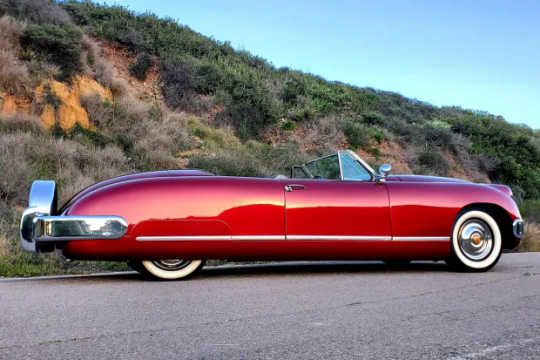
Custom 1953 Muntz Jet Convertible
The steel, aluminum, and fiberglass body is mounted on an Art Morrison ladder frame that was boxed and finished in semi-gloss black, and the floor was raised 3″. The exterior was repainted in a Sherwin Williams two-stage Apple Pearl mixed by the late Stan Betz. Features include a chopped Duvall-style windshield, 1950 Chevrolet headlights, dual Appleton spotlights, 1951 Ford Victoria side windows, and a white removable Carson-style top fabricated to match the height of the chopped windshield. Additional equipment includes color-matched rear fender skirts and chrome bumpers. Wear from fitting the top is noted on the rear deck.
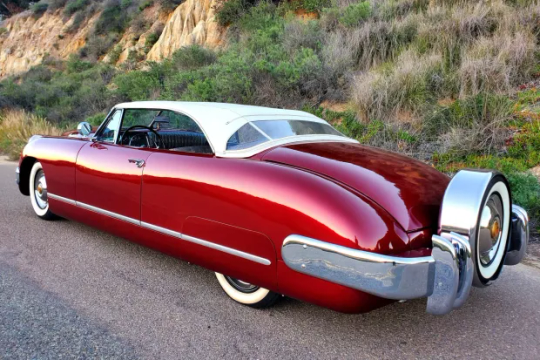
Custom 1953 Muntz Jet Convertible
Steel wheels sourced from a 1976 Dodge measure 15″ and are mounted with Cadillac Sombrero-style covers and whitewall tires. A matching spare fitted with a BFGoodrich Silvertown tire is mounted within a rear-mounted Continental-style chrome carrier. A Mustang II front end accommodates power rack-and-pinion steering , and the car rides on an electronically-adjustable Air Ride Technologies airbag suspension system along with 2” lowered front spindles, Strange Engineering tube shocks, a rear Panhard bar, and front and rear sway bars. The seller reports that the front control arm bushings were recently replaced.
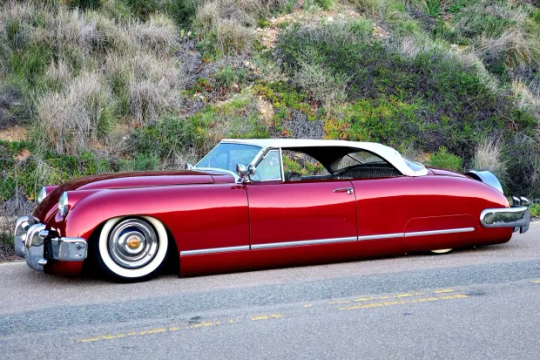
Custom 1953 Muntz Jet Convertible
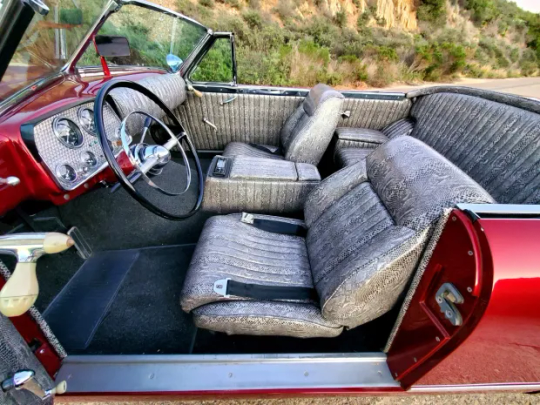
Custom 1953 Muntz Jet Convertible
Braking is handled by GM G-body-sourced calipers matched with Ford Granada discs up front and Ford SVO-specification calipers and discs at the rear.
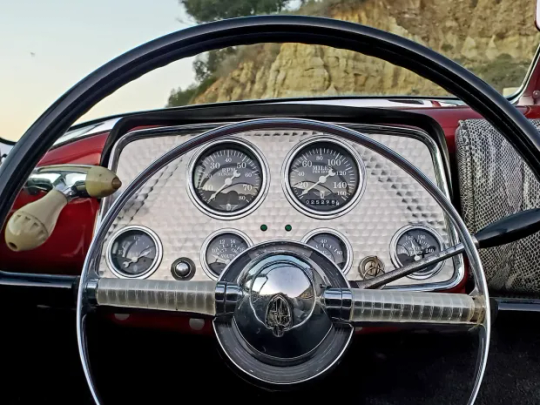
Custom 1953 Muntz Jet Convertible
The cabin was customized by Jim’s Auto Trim of San Diego, California, and features Glide bucket seats and a rear bench trimmed in gray snakeskin-style Naugahyde upholstery, along with matching treatments for the dash trim, headliner, and door panels. Additional equipment includes a 1952 Lincoln steering wheel mounted to a shortened Lincoln steering column, gray cut-pile carpet, and a Pioneer stereo housed within a custom center cubby.
The engine-turned “Hollywood” instrument cluster houses Stewart Warner gauges consisting of an 8k-rpm tachometer, a 160-mph speedometer, and auxiliary readings for fuel level, battery charge, oil pressure, and water temperature. The five-digit odometer displays 25k miles, though total chassis mileage is unknown. A Lokar pedal assembly was fitted during the build.

Custom 1953 Muntz Jet Convertible
The Corvette-sourced 5.7-liter LT1 V8 features a polished fuel intake manifold along with billet aluminum valve covers, and additional features include an Opti-Spark distributor, a Griffin aluminum radiator, and a wiring loom sourced from Painless Performance Wiring. A set of long-tube headers are connected to a 2.5″ exhaust system equipped with dual Dynaflow mufflers. The seller reports that the oil was recently changed.
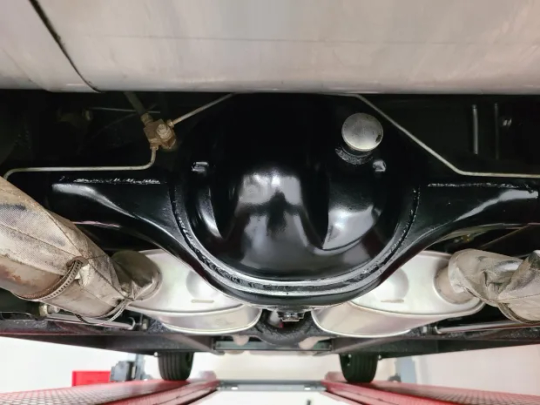
Custom 1953 Muntz Jet Convertible
Power is routed to the rear wheels via a four-speed 4L60E automatic transmission and a Ford 9″ rear end with with 3.55:1 gears and Strange Engineering 31-spline axles. Additional photos of the underside, drivetrain, and suspension components are presented in the gallery below.
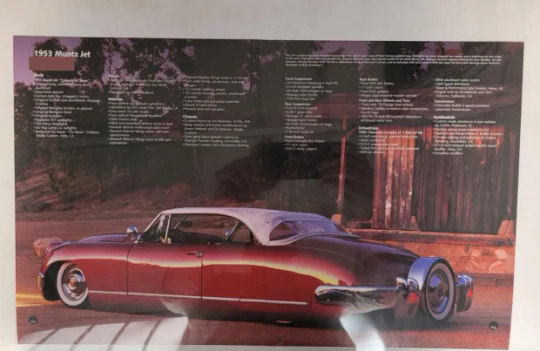
Custom 1953 Muntz Jet Convertible
The car was featured in issue #36 of Rodders Journal magazine
#Custom 1953 Muntz Jet Convertible#Custom 1953 Muntz Jet#Muntz Jet Convertible#Custom Muntz Jet Convertible#Muntz Jet#Convertible#car#cars#muscle car#american muscle
111 notes
·
View notes
Text
1969 Camaro InVision Digital Dash Model 7008
The new InVision Direct Fit Digital Dash System for 1969 Camaro (Model #7008) is a one model solution for your entire dash. Monitor the speedometer, tachometer, fuel level, oil pressure, water temperature, and volts all in one place. The InVision Digital Dash features a 12.3" LCD with four user-selectable screens. All kits include a wiring harness and sending units for water temperature and oil pressure. This dash features an adjustable RPM range and displays in imperial or metric units. An integrated joystick allows for easy programming. The InVision Digital Dash will help protect your car with visual and audio alarms for low fuel level, low oil pressure, high water temperature, and low voltage. The speedometer easily calibrates to an OEM or aftermarket vehicle speed sensor and the tachometer is capable of calibrating to many engine types. Upgrade your dash with the latest, modern LCD direct fit offering from AutoMeter. #rpmmag #rpmmagazine #rpm25yrs #autometer #InVision Read the full article
1 note
·
View note
Text
Kawasaki Eliminator Launched In India At Rs 5.62 Lakh

2024 Kawasaki Eliminator
Kawasaki Eliminator cruiser 2024 launched in India at Rs 5.62 lakh
Japanese two-wheeler manufacturer Kawasaki has launched the the 2024 Eliminator in India. It is priced from Rs 5.62 lakh ex-sh in India. The power cruiser was unveiled at India Bike Week 2023.
Kawasaki Eliminator styling
Kawasaki Eliminator seems like a modern interpretation of a cruiser. The Eliminator will be available in a single colour option – Metallic Flat Spark Black and the deliveries are set to begin by the end of January 2024.
This motor gets a 6.8mm longer stroke, a larger airbox and bigger 32mm throttle bodies.
You may like it : Top 10 Bikes in India 2024

Kawasaki Eliminator with 451cc
If we talk about features, the cruiser comes equipped with a round LCD instrument console and gives out readings such as speedometer, digital bar-style tachometer, gear position indicator, clock, odometer, dual trip meters, fuel gauge, remaining fuel range, current and average fuel consumption, coolant temperature, maintenance reminder, smartphone mail and call notices.
It also comes with smartphone connectivity through Kawasaki’s Rideology app.
You may like it : Best Scooters For Women
Kawasaki Eliminator performance
The bike debuts a new 451cc parallel twin motor that is borrowed from the engine in the Kawasaki Ninja 400. It deliver 48 hp of max power and 37 Nm of peak torque.This motor gets a 6.8mm longer stroke, a larger airbox and bigger 32mm throttle bodies and makes 45.4PS at 9000rpm and 42.6Nm at 6000rpm. Paired with a 6-speed gearbox.
Kawasaki Eliminator comes with a kerb weight of just 176kg, the Eliminator is a pretty lightweight motorcycle for the 450cc cruiser segment along with Steel trellis frame suspended on telescopic fork and dual shock absorbers.
You may like it : Aprilia RS 457 Accessories list Revealed
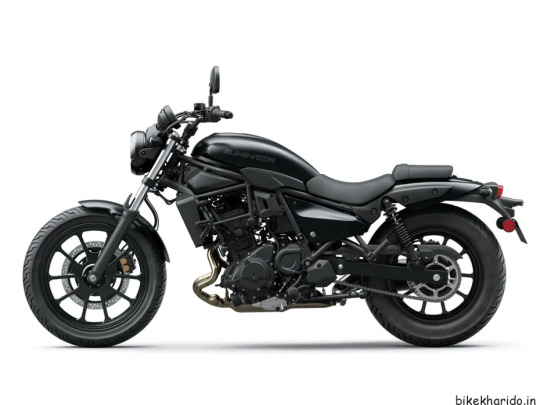
Kawasaki Eliminator cruiser
0 notes
Text
A Comprehensive Guide to Instrument Cluster Repair
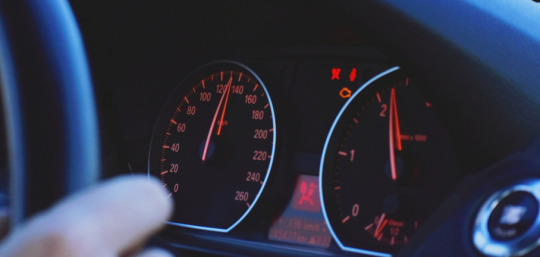
Your vehicle's instrument cluster—the dashboard display behind your steering wheel—plays a vital role in delivering essential driving information. From speed and RPM to fuel levels and warning lights, the instrument cluster ensures you're always in tune with your vehicle's performance and safety.
With the evolution of technology, the traditional analog displays have been replaced or supplemented by the Automotive Digital Instrument Cluster. These digital systems offer enhanced features, improved aesthetics, and better integration with vehicle electronics. However, like all electronic components, they are not immune to failure.
In this comprehensive guide, we’ll explore the intricacies of instrument cluster repair, from diagnosing common issues to steps for repair and replacement. Whether you're a DIY enthusiast or seeking guidance before visiting a repair shop, this guide will provide the clarity you need.
What is an Instrument Cluster?
The instrument cluster is the collection of displays behind the steering wheel, traditionally composed of analog gauges that show:
Speed (speedometer)
Engine RPM (tachometer)
Fuel levels
Engine temperature
Odometer and trip meter
Warning indicators (battery, oil, seatbelt, check engine)
In today’s vehicles, particularly newer and luxury models, this area has become highly digitized. Instead of analog dials, you’ll find LCD or LED displays powered by embedded software. These modern systems are referred to as the Automotive Digital Instrument Cluster, offering real-time insights, customization options, and seamless communication with other car systems.
Introduction to the Automotive Digital Instrument Cluster
An automotive digital instrument cluster replaces traditional analog gauges with sleek, high-resolution LCD or LED screens. These cutting-edge interfaces go far beyond just showing your speed or fuel level. They serve as a central hub for driving intelligence, bringing together essential data from various vehicle systems in one streamlined view.
Unlike older dashboards with fixed dials and limited functionality, digital clusters are dynamic and fully programmable. They not only provide basic driving information like speed, RPM, fuel level, and engine temperature, but also support advanced capabilities such as:
Turn-by-turn GPS navigation
Real-time traffic and weather alerts
Driver-assist system feedback
Adaptive cruise control status
Media and phone integration
Live engine diagnostics and maintenance alerts
Heads-up display (HUD) compatibility
In vehicles equipped with a fully digital cockpit, the instrument cluster often works in tandem with the infotainment system and central control unit, delivering a unified driving experience.
Common Problems in Instrument Clusters
Instrument clusters, whether traditional analogue or advanced digital, are essential for providing drivers with real-time feedback about their vehicle's performance and safety status. However, over time or due to electrical faults, they can develop various issues. Below are some of the most common problems seen in both analogue and automotive digital instrument cluster systems, along with brief explanations of their causes.
a. Dead Gauges
Gauges like the speedometer, tachometer, oil pressure, or fuel level indicators may stop responding entirely. This is usually caused by a failed stepper motor (in analogue clusters), damaged internal circuits, or faulty sensor input from the vehicle's ECU. In digital clusters, software bugs or a corrupted display controller can also cause gauges to freeze or disappear.
b. Flickering or Dim Display
This issue is prevalent in automotive digital instrument clusters with LCD or LED screens. A flickering display may point to a failing backlight inverter, degraded ribbon cables, or a fluctuating power supply. Inconsistent brightness or a completely dim screen makes the cluster unreadable and dangerous while driving at night.
c. Malfunctioning Warning Lights
The check engine, ABS, airbag, and battery lights are essential for vehicle diagnostics. These lights may illuminate falsely (when no issue exists) or fail to turn on when a real fault occurs. This could be due to a damaged cluster PCB (printed circuit board), short circuits, or corrupted firmware. In digital systems, it may also stem from software errors or CAN-bus miscommunication.
d. Pixelation or Screen Failure
In digital clusters, screen degradation may show up as missing pixels, horizontal/vertical lines, or full blackouts. This could be caused by water damage, physical impact, or a malfunctioning TFT/LCD controller. Over time, wear and tear can also degrade the screen’s contrast and refresh rate, affecting visual clarity.
e. Data Errors
Incorrect readings—such as a fuel gauge showing full when the tank is empty or a speedometer stuck at zero—can occur due to faulty sensors, damaged wiring, or software bugs in the digital processor. In automotive digital instrument clusters, improper calibration or firmware glitches can lead to frequent data inconsistencies, which not only confuse the driver but may also hinder safety system functions.
f. Power Issues
If the entire cluster doesn’t power on, randomly resets, or experiences intermittent operation, it might be due to blown fuses, shorted circuits, or a faulty power control module. In digital systems, software crashes, battery voltage drops, or grounding issues may also cause the display to reboot unexpectedly, especially during engine cranking or cold starts.
g. Communication Faults
Modern vehicles rely heavily on internal communication networks like CAN (Controller Area Network) or LIN Bus. If there’s a disruption in these networks, the Automotive Digital Instrument Cluster may lose connection to essential data sources such as the engine control unit (ECU) or transmission control unit (TCU). This often results in missing information, ghost warnings, or a completely non-functional dashboard.
Accurate Diagnosis Before Instrument Cluster Repair
Before jumping into the repair process, an accurate diagnosis is required. The automotive digital instrument cluster is a sophisticated component that integrates with various vehicle systems, meaning an issue might originate from the cluster itself—or from external sensors, wiring, or the ECU. Misdiagnosing the problem can lead to unnecessary repairs, higher costs, or recurring faults.
Here’s a step-by-step guide to correctly identifying the root cause of the problem:
Step 1: Visual Inspection
Start with a thorough visual check of the instrument cluster and its immediate surroundings. Remove the cluster housing if necessary and inspect:
Connectors: Look for loose plugs, corroded pins, or damaged locking tabs.
Burnt Components: A burnt smell or visible discoloration may indicate a short circuit on the cluster's PCB.
Cracked Solder Joints: Especially around areas where the cluster experiences vibration.
Moisture or Water Damage: This is a common cause of display issues and pixelation in digital clusters.
If the vehicle has recently undergone dashboard work or an aftermarket device was installed (e.g., stereo, alarm, GPS tracker), ensure no harnesses were tampered with or misrouted.
Step 2: Use a Diagnostic Scanner
Plug in an OBD-II (On-Board Diagnostics) scanner to retrieve fault codes related to the cluster, ECU, or communication lines. Many automotive digital instrument clusters are tied into CAN-bus or LIN-bus systems, and scanning will reveal if the cluster is receiving or transmitting incorrect data.
Look for fault codes such as:
U0155 – Lost Communication With Instrument Panel Cluster
B2601/B2603 – Display circuit failure
U0422 – Invalid Data Received From Body Control Module
Advanced scan tools (e.g., Autel, Launch, Bosch, Snap-On) may also let you run live tests on the cluster's display, gauge response, and warning lights.
Step 3: Electrical Testing
Use a digital multimeter to perform voltage, continuity, and ground checks:
Battery Voltage: Ensure the cluster is receiving the correct voltage from the fuse box. A voltage drop can cause flickering or a complete power-off.
Ground Connection: A poor ground can lead to erratic behavior, dim lights, or failure to boot.
Continuity Tests: Check the wiring harness from the cluster to the ECU and sensors for breaks, corrosion, or shorts.
Backlight Circuit Check: If backlights are dim or flickering, test for stable power supply to the LED driver circuits.
Testing the circuit at different ignition stages (ACC, ON, CRANK) can help determine if a voltage drop or power surge is causing intermittent faults.
Step 4: Observe Symptom Patterns
Pay close attention to when and how the problem manifests. Tracking symptom patterns will help narrow down the cause:
During Ignition: Flickering or rebooting during engine start may indicate weak power delivery or cluster capacitor failure.
After Hitting a Bump: Suggests a loose connector, dry solder joint, or vibration-sensitive failure.
Intermittent Glitches: Points toward failing internal components, memory corruption, or thermal sensitivity.
Only in Cold/Hot Weather: Might indicate temperature-sensitive components, particularly in LCD screens or solder joints.
Specific Driving Modes: If issues only arise in Eco/Sport modes, it could involve software conflicts or CAN-bus messaging faults.
This observational data will be especially valuable if you need to consult a technician or plan for a deeper teardown.
Step 5: Test with a Known Good Unit
If available, swap out the suspected cluster with a working, compatible instrument cluster. This is often the most direct way to isolate whether the fault lies within the unit itself or elsewhere in the vehicle system.
Important Considerations:
Ensure the test cluster matches the vehicle make, model, and trim level to prevent communication mismatches.
Some automotive digital instrument clusters require VIN-coding or immobilizer sync, so you may need dealer-level diagnostic tools (e.g., Techstream, VCDS, Forscan).
If the symptoms disappear after the swap, the original cluster is faulty. If they remain, focus on sensors, wiring, or control modules.
Repair vs. Replacement: What Should You Choose?
Depending on the issue, you may consider repairing or replacing your cluster. Here’s a breakdown:

For rare or luxury vehicles with unique automotive digital instrument clusters, repair is often the only feasible option.
Step-by-Step Instrument Cluster Repair Process
Repairing an instrument cluster, especially a modern automotive digital instrument cluster, requires precision, attention to detail, and a basic understanding of electronics. Here’s a detailed breakdown of the general repair process:
Step 1: Disconnect the Battery
Safety always comes first. Before touching any part of your vehicle’s electrical system, disconnect the car battery, preferably starting with the negative terminal. This eliminates the risk of short circuits, electrical shocks, or accidentally triggering airbags when handling digital dashboard components. Let the vehicle sit for a few minutes after disconnecting to allow any residual charge to dissipate from the capacitors.
Step 2: Remove the Instrument Cluster
Carefully dismantle the dashboard.
Remove surrounding panels using a trim removal tool to avoid damaging plastic clips.
Unscrew mounting bolts holding the cluster in place—usually Torx or Phillips screws.
Gently pull out the cluster, being mindful of its size and shape.
Disconnect the wiring harnesses one by one, ensuring you don’t bend or damage the pins. Some clusters also have locking tabs on connectors that need to be depressed before removal.
Marking connector positions or photographing the setup beforehand helps during reinstallation
Step 3: Open the Cluster
Once removed, place the cluster on a clean, static-free surface. Use an anti-static wrist strap and proper tools to open the casing, which often includes plastic clips or small screws.
Take your time here—modern clusters, especially digital ones, use delicate PCB assemblies and ribbon cables that can be damaged easily. If the cluster is sealed or potted (common in some digital models), you may need specialized tools or heating methods to soften the adhesive.
Step 4: Identify Faulty Components
Visually inspect the internal components:
Look for physical damage like burnt resistors, leaking capacitors, or blackened areas.
Check solder joints, especially on high-vibration areas like connector pins and voltage regulators—cracks can cause intermittent faults.
In automotive digital instrument clusters, check the LCD driver circuits, processor ICs, and signal transceivers.
Use a magnifying glass or microscope if needed to spot fine cracks or corrosion, particularly in high-humidity environments.
If you’re unsure, a thermal camera or oscilloscope can help locate malfunctioning components.
Step 5: Repair or Replace Components
Use a fine-tip soldering iron or hot air tool to remove and replace faulty capacitors, resistors, or ICs. For LCD issues in automotive digital instrument clusters, replace the screen or driver board carefully, handling ribbon cables with caution. After repairs, clean the PCB with isopropyl alcohol to remove solder residue and ensure solid, clean solder joints.
Step 6: Test the Cluster
Before reinstalling, test the cluster using a bench simulator if available to verify gauge movements, display clarity, and warning light functionality. If no simulator is available, temporarily reconnect the cluster in the vehicle to check for errors or abnormal behavior during startup and operation.
Step 7: Reinstall and Reconnect
Reconnect all wiring harnesses securely, mount the cluster properly, and replace any dashboard panels. Reconnect the battery, start the car, and observe the instrument cluster for proper startup, gauge sweep, and accurate readings. Take a short test drive to confirm everything works correctly.
7. Tools Required for Instrument Cluster Repair
Screwdrivers (Phillips and Torx)
Soldering iron and solder
Multimeter
Anti-static mat and wrist strap
OBD-II scanner
Digital cluster simulator (optional)
Magnifying glass or microscope (for PCB inspection)
Hot air rework station (for surface-mounted devices)
Preventative Maintenance Tips
While electronic failures in instrument clusters can sometimes be unavoidable, there are several proactive steps you can take to minimize the risk and prolong the life of your automotive digital instrument cluster:
a. Avoid Electrical Surges
Install a surge protector or voltage stabilizer to shield your vehicle’s electrical system from sudden voltage spikes. Regularly maintain your battery’s health by checking terminals and charging levels to prevent unexpected surges that can damage sensitive instrument cluster components.
b. Protect From Moisture
Keep your vehicle’s interior dry by promptly fixing leaks and using moisture absorbers if necessary. Moisture can cause corrosion on circuit boards and connectors, leading to malfunction or failure of the instrument cluster’s delicate electronic parts over time.
c. Gentle Driving
Drive carefully over rough terrain, avoiding sharp bumps and potholes whenever possible. Harsh jolts and vibrations can loosen or damage internal cluster components, especially fragile solder joints and delicate sensors, which may cause intermittent faults or complete failure.
d. Software Updates
Keep the Automotive Digital Instrument Cluster’s firmware up to date by following manufacturer recommendations or visiting authorized service centers. Software updates often include bug fixes, improved system stability, and new features that enhance cluster performance and reliability.
Professional Repair Services: What to Expect
If DIY repair isn’t your style, professional services offer precision and warranty-backed repairs.
What They Offer:
Detailed diagnostics
Chip-level repairs
Screen and LED replacements
Firmware updates
Odometer correction (legal limitations apply)
Choosing a Repair Shop:
Look for specialization in digital clusters
Check online reviews
Ask for warranty terms
Ensure compliance with legal standards for odometer readings
Cost of Instrument Cluster Repairs
Costs vary depending on the vehicle make, model, and the type of cluster (analog vs. digital).
Estimated Costs:
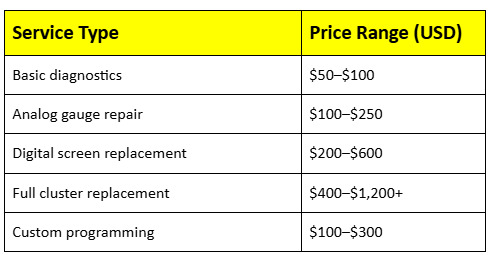
For high-end vehicles with a sophisticated Automotive Digital Instrument Cluster, prices can climb significantly.
Conclusion
Your instrument cluster is more than just a display—it’s a critical part of your vehicle’s communication system. It provides you with essential information such as speed, fuel levels, engine temperature, and warning indicators that help ensure your safety on the road. As technology advances, the automotive digital instrument cluster becomes increasingly central to the driving experience, offering customisable interfaces, navigation, and integration with driver-assist systems. However, with this increased complexity comes a higher chance of malfunction or failure, which can affect your ability to monitor vital vehicle functions accurately.
Understanding how to diagnose, repair, or replace your cluster empowers you to make informed decisions, whether you’re tackling the repair yourself or working with a professional technician. By staying proactive—performing regular maintenance, updating software, and promptly addressing warning signs—you can ensure your instrument cluster remains reliable and accurate for years to come. This not only enhances driving safety but also helps preserve your vehicle’s value and performance over time.
#InstrumentClusterRepair#CarDashboardRepair#AutomotiveRepairGuide#DashboardDisplay#CarTechFix#DigitalInstrumentCluster#VehicleDiagnostics#AutoTechTips#InstrumentPanelFix#DIYCarRepair#AutomotiveDigitalInstrumentCluster#ClusterRepairTips#CarMaintenance#AutomotiveTechnology#FixYourCar
0 notes
Text
Global Automotive Instrument Cluster Market Size, Share, Growth Analysis, By Cluster type.(analog, digital and hybrid), By Vehicle Type(passenger cars, light commercial vehicle)
Global Automotive Instrument Cluster Market Insights
Global Automotive Instrument Cluster Market size was valued at USD 2.76 billion in 2021 and is poised to grow from USD 2.98 billion in 2022 to USD 5.92 billion by 2030, growing at a CAGR of 8% in the forecast period (2023-2030).
The instrument cluster is the primary data source for the driver, providing information on the vehicle's various operational parameters. It sends vehicle data such as speed, fuel level, tachometer, and temperature, as well as data from the in-vehicle network, cameras, and multimedia. Cluster graphics platform for displaying graphics data on a display, cluster controller platform for handling AUTOSAR stack functionality, and integrated cluster platform that combines graphics controller and real-time application controller capability. The purpose of the instrument cluster is to provide the driver with the most up-to-date information while driving. Gauges are used to measure speed, distance, heat, and fuel. Indicator lights that provide warnings and updates include the check engine light and the low fuel light. Different alerts are available for various vehicles. In most cases, the gauges in the instrument cluster are circular and backlit. On the driver's side of the dashboard, directly in front of the steering wheel, you'll find the speedometer, fuel gauge, tachometer, and odometer. The speedometer displays the current speed of the vehicle. The fuel gauge displays the amount of gas remaining in your tank. The tachometer indicates how fast the crankshaft of the engine is spinning. The odometer displays the vehicle's distance travelled.
Global vehicle production and sales growth, as well as advancements in infotainment systems, drive market growth. However, price fluctuations in raw materials such as chips, ICS, and displays, as well as higher costs associated with digital instrument clusters, are impeding market growth. These constraints can be overcome by technological advancements such as the release of an automotive instrument cluster with a new and advanced screen, as well as biometric features, which are expected to present numerous market expansion opportunities.
Global Automotive Instrument Cluster Market Segmental Analysis
Global automotive instrument cluster market is segmented based on the cluster type, vehicle type and region. Based on cluster type, the Automotive Instrument Cluster Market is segmented into analog, digital and hybrid. Based on vehicle Type, the Automotive Instrument Cluster Market is segmented into passenger cars, light commercial vehicle, heavy commercial vehicle and electric vehicle. Based on Region Automotive Instrument Cluster Market is categorized into North America, Europe, Asia-Pacific, Latin America, and MEA.
Automotive Instrument Cluster Market Analysis by Cluster Type
Based on Age group, the hybrid segment is expected to dominate the digital instrument cluster market share During the forecast period. The hybrid system is a combination of digital and analogue displays that displays information such as speed, fuel economy, mileage, and temperature in both formats. The analogue system includes a speedometer and an odometer, whereas the digital display system includes an LCD screen that displays all relevant information such as temperature, distance travelled, traffic data, and other warning indicators. During the forecast period, the digital system is expected to dominate the market.
Automotive Instrument Cluster Market Analysis by Vehicle Type
Based on vehicle type, the passenger car segment is expected to dominate the market During the forecast period. The market is dominated by entry-level and mid-sized cars in the passenger car segment. Furthermore, rising urbanisation, a high population rate, an improved standard of living, and an increase in people's disposable income are driving up sales and production of passenger cars, ultimately increasing global demand for passenger cars.
0 notes